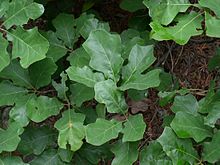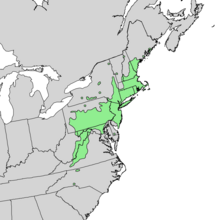Quercus ilicifolia
| Quercus ilicifolia | |
|---|---|
 |
|
| Quercus ilicifolia on North Fork Mountain, West Virginia, USA. | |
| Scientific classification | |
| Kingdom: | Plantae |
| (unranked): | Angiosperms |
| (unranked): | Eudicots |
| (unranked): | Rosids |
| Order: | Fagales |
| Family: | Fagaceae |
| Genus: | Quercus |
| Section: | Lobatae |
| Species: | Q. ilicifolia |
| Binomial name | |
|
Quercus ilicifolia Wangenh. 1787 not Salisb. 1864 nor Koord. & Valeton ex Seemen 1900 |
|
 |
|
| Natural range | |
| Synonyms | |
|
List
|
|
Quercus ilicifolia, commonly known as bear oak or scrub oak, is a small shrubby oak native to the eastern United States and southeastern Canada. Its range extends in the United States from Maine to North Carolina, with reports of a few populations north of the international frontier in Ontario. The name ilicifolia means "holly-leaved."
Quercus ilicifolia is a deciduous tree or shrub growing occasionally reaching a height of 6 meters (20 feet) but usually much smaller. It is "gangly" and can form a dense thicket. The plant grows from a large taproot which can be up to 20 centimeters (8 inches) thick. The taproot lives a long time, producing several generations of above-ground parts. The alternately arranged leaves are each up to 15 centimeters (6 inches) long by 10 cm (4 inches) wide. The species is monoecious, with plants bearing both male catkins and solitary or clustered female flowers. The egg-shaped acorn is 1 to 2 centimeters (0.4-0.8 inch) long with a saucer-shaped cap. The plant reproduces sexually by seed and also vegetatively by sprouting new stems.
Quercus ilicifolia is a dominant plant species in a number of regions and habitat types. In Maine it can be found in deciduous forests alongside red maple (Acer rubrum), gray birch (Betula populifolia), and quaking aspen (Populus tremuloides). In Massachusetts it codominates with black huckleberry (Gaylussacia baccata) on the shrublands of Nantucket and Martha's Vineyard. On Cape Cod it occurs with pitch pine (Pinus rigida) and broom crowberry (Corema conradii). It can be found on the Pine Barrens of New Jersey and pine barrens habitat on Long Island. It also occurs in fire barrens on granite and gneiss further north in Canada. This oak is adapted to disturbance in the habitat, such as wildfire. Hence, it does not tolerate shade and it requires disturbance to clear remove other plant species so it can receive sunlight. It sprouts prolifically after fire burns away its above-ground parts.
...
Wikipedia
